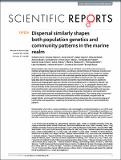Por favor, use este identificador para citar o enlazar a este item:
http://hdl.handle.net/10261/316469COMPARTIR / EXPORTAR:
 SHARE SHARE
 CORE
BASE CORE
BASE
|
|
| Visualizar otros formatos: MARC | Dublin Core | RDF | ORE | MODS | METS | DIDL | DATACITE | |

| Título: | Dispersal similarly shapes both population genetics and community patterns in the marine realm. |
Autor: | Chust, Guillem; Viilarino, E.; Chenuil, A.; Irigoien, Xabier; Bizsel, N.; Bode, Antonio CSIC ORCID CVN; Broms, C.; Claus, S.; Fernández-de-Puelles, María Luz; Fonda-Umani, Serena; Hoarau, G.; Mazzocchi, Maria Grazia; Mozetič, Patricija; Vandepitte, L.; Veríssimo, H.; Zervoudaki, Soultana; Borja, A. | Palabras clave: | Centro Oceanográfico de A Coruña Medio Marino plankton benthos community composition diversity Genetic structure NE Atlantic |
Fecha de publicación: | 27-jun-2016 | Citación: | Scientific Reports, 6. 2016: 1-12 | Resumen: | Dispersal plays a key role to connect populations and, if limited, is one of the main processes to maintain and generate regional biodiversity. According to neutral theories of molecular evolution and biodiversity, dispersal limitation of propagules and population stochasticity are integral to shaping both genetic and community structure. We conducted a parallel analysis of biological connectivity at genetic and community levels in marine groups with different dispersal traits. We compiled large data sets of population genetic structure (98 benthic macroinvertebrate and 35 planktonic species) and biogeographic data (2193 benthic macroinvertebrate and 734 planktonic species). We estimated dispersal distances from population genetic data (i.e., FST vs. geographic distance) and from β-diversity at the community level. Dispersal distances ranked the biological groups in the same order at both genetic and community levels, as predicted by organism dispersal ability and seascape connectivity: macrozoobenthic species without dispersing larvae, followed by macrozoobenthic species with dispersing larvae and plankton (phyto- and zooplankton). This ranking order is associated with constraints to the movement of macrozoobenthos within the seabed compared with the pelagic habitat. We showed that dispersal limitation similarly determines the connectivity degree of communities and populations, supporting the predictions of neutral theories in marine biodiversity patterns. | Versión del editor: | http://www.nature.com/articles/srep28730 | URI: | http://hdl.handle.net/10261/316469 | DOI: | 10.1038/srep28730 |
| Aparece en las colecciones: | (IEO) Artículos |
Ficheros en este ítem:
| Fichero | Descripción | Tamaño | Formato | |
|---|---|---|---|---|
| Chust_SRep_2016_doi_10_1038_srep28730.pdf | original article | 792,41 kB | Adobe PDF |  Visualizar/Abrir |
CORE Recommender
PubMed Central
Citations
14
checked on 08-abr-2024
SCOPUSTM
Citations
45
checked on 24-abr-2024
WEB OF SCIENCETM
Citations
40
checked on 23-feb-2024
Page view(s)
13
checked on 29-abr-2024
Download(s)
18
checked on 29-abr-2024

